

These three were recommended by LVRMNA members.
Colle’s Clearners, brush and landscape work. $20/hr for each person in the crew, 210-8696. “Great young guys; you’ll be happy."
Martin Ramirez, Landscaping: 271-1304 or 575-6102. Jack of all landscaping trades. “Hard worker."
These next two are recommended by Joanne Drummond at the Firesafe Council:
Ben McPherson 530-802-2111
Walter’s Outdoor Maintenance 530-615-6438 (He is working on getting a contractor's licence.)
Crew size Per hour Discount rate/only for those on a fixed income
Crew of 2=$77,63 per hour, 10%= $69.87 per hr.
Crew of 3=$100,63 per hour, 10%= $90.57 per hr.
Crew of 4=$123.63 per hour, 10%= $111.27 per hour
Crew of 5=$146.63 per hour, 10%= $131,97 per hour
Crew of 6=$169.63 per hour, 10%= $152,67 per hour
The 15% discount applies only to people on/a fixed income.
Maggie Orion submitted this recommendation for weed eating:
Hi Jim,
I use Rebecca Baer for weed eating. She’s professional and efficient and returns calls quickly. She charges $30/hr. She charged far less than a landscaper’s quote and did a much better job than a guy I had hired previously. She has worked alone for me twice with a focus on fire safety and house clearance. I’m not sure she has a crew. My understanding is she does other yard work too. Her number is 530-559-5859.
Take care,
MaggieP.S. Later added: Included in this rate is a degree in horticulture, 20 years of experience and one million in liability insurance. I'm also licensed through the Ag. Department to spray herbicide and pesticide.
Here is a report from Rick Sharkey:
Jim, I have another strong recommendation for a property cleanup business in our area. Yesterday, a crew finished the cleanup up of our property of five acres. They did weed whacking, tree trimming, dead tree removal, wood chipping, and even cleaned out our rain gutters and cleaned off the roof at no extra charge! They did it all in two days. They did a fantastic job!
The first day was three workers. The second day was four workers who did weed eating, tree trimming and cutting, wood chipping and blowing off our pathways, rooftop, and rain gutters. Total cost was $1,400. Or $180/hour for four workers. Well worth it for five acres and two days of onsite work. The property looks the best it has looked in the past seven years!
The business is called Luna's Landscaping in Penn Valley. Their number is 432-7725. We are very pleased with the results and will use them again next year.
Here is a report from Annie Berreman on New Rome Rd.
Hi Jim,
Just wanted to pass on a name, Richard Caabot, of someone who happens to live on Bloomfield Ave. that works on sprinklers/irrigation and gardening work. He repaired my sprinklers for me today, and I couldn't have been more pleased with his service and price. He was very professional from the get go, and knew what he was doing. Thought perhaps others might be needing this service.
His hourly rate was $25/hr. He bought whatever parts were needed, and my total end bill was $200. I was very pleased. Part of what he was doing was fixing a leak. He even said he would come back for free if the leak is not turns out not fixed. Very professional, kind and caring.
Richard Chabot
530-470-3190 (texting also)
tonychbt@gmail.comSincerely, Annie Berreman on New Rome
Go to: http://www.insurance.ca.gov/01-consumers/105-type/5-residential/Top10Tips_FindingResidentialIns.cfm
Where you will find the "Top Ten Tips For Finding Residential Insurance." Lots of good advice.
Members comments:
Jim,
AAA has been “cancelling” everyone – but it’s not exactly cancelling, it’s “no longer covering fire and wind.” I had to scramble as they did not give me much notice. Then, no other agents would cover fire at my address, so I had to go with California Fair Plan. CA Fair Plan is expensive, of course, plus they don’t want us! So they send threatening letters, even after taking your $ (no check or credit card accepted, they need your bank numbers and help themselves to the money). They tell you they are going to send an inspector out on a mutually agreed date to see if your property “qualifies.” Then the inspector shows up at your door unannounced. Then you get another threatening letter saying you’d better clean your roof and send them proof (mind you, the inspector came right after a big wind storm and there were a few (not many) pine needles on my roof. They also said to clean my rain gutters, but my gutters are covered with a fine steel mesh. The inspector was only here less than 5 minutes, and could not have seen that my gutters were covered.) Meanwhile, AAA got money for brokering the Fair Plan policy and also is charging me over $800 a year to cover everything besides fire and wind (like what?). I asked them if they would cover a tree falling on my house, and they said it depended on whether wind was involved. I know several neighbors who also got cancelled, and they don’t care that we are in a firewise neighborhood.
Other insurance companies are not cancelling like AAA, but also not writing new policies for certain neighborhoods, including ours.
Karen Anderson
----------------------------------------------
Hello Jim,
FYI
My dad who lives next to me (he's 95, we take care of him) up here on Banner has had Farmers forever. His rate last year went from about 1400 to 2800.
----------------------------------------------
Hello Jim,
FYI
My dad who lives next to me (he's 95, we take care of him) up here on Banner has had Farmers forever. His rate last year went from about 1400 to 2800. He is in a metal roof house, cement board siding, ironwood deck and good tree clearance. It is all about the rating...
Jeff Peach
-----------------------------
Working in Real Estate this has become problem we have had some good luck with these agents & companies
Todd Marsh with AAA 530-271-2615
John Eisenhower with Lake Olympia Insurance 530-274-2704
Valda Luckey
————————————
Hi Jim,
We lost out Hartford policy in September. They dropped the whole area. We renewed through Lloyds. It was more expensive but the best we could find.
Emily Snelling
———————————————
I have a reasonably priced policy from Nationwide Insurance Co. I got it thru my broker in SF, Blum Blackfield Insurance Agency.
A friend up on banner was in a bind for insurance and ended up having to get coverage thru Lloyd's of London, that was over double what she was paying. At least Julie can get a quote from a standard domestic insurer.
Paul Badaracco
———————————————
Hi Jim, being a new homeowner, I experienced the same thing when we bought our house. It was previously insured by State Farm, who had NO interest in issuing a new policy for the exact same house. Same for all the major insurers – I must have tried 20 of them. They’re not issuing new policies in Nevada County any longer – or at least, not until it rains more. Disturbing, indeed, that some are now refusing to renew.
I became an unwilling expert in this topic when we bought this house. I called 4-5 different insurance brokers, several up here and one in the Bay Area. All of them came back with quotes – and every quote traced back to Lloyd’s of London. Lloyd’s appears to be about the only option. Their policies are sold through a variety of middle men with varying degrees of financial bench strength – but if you dig into who’s carrying the risk behind the scenes, it was always Lloyd’s.
I spent a lot of time on this, and am happy to share my experience with anyone else who has to go through this. I would also highly recommend the broker we ended up going with. Although he’s in the Bay Area, he got us the best coverage package at the best price of all the brokers and quotes. It ended up costing us $2400/year, but I don’t think that’s too bad for this house and property.
My broker’s name is Jack Klein. He did an excellent job for us, and I would highly recommend him. He was very transparent, and walked me through all the nuances of making sure we picked a re-issuer that was affordable (given the circumstances), viable and reputable. He’s an independent broker, his company is Jack Klein General Insurance. Phone is (650) 364-5900, email is jkgiagency@sbcglobal.net He will remember me and our situation up here, so folks can feel free to reference my name if they want.
Feel free to share my phone number with the Goldman’s – I’m happy to talk with them if they want.
And let it rain!!!
Thanks
Shari Elia
408.569.5153
——————————————————
Judy wrote:
We are insured through Costco's Ameriprise for 950. Previously we had State Farm for 1500.
Judy Fitanides
------------------------------------------------------
James Babe wrote:
I just switched from Hartford to Progress for home and auto and saved $800/yr it was about 1/3 less.
------------------------------------------------------------------------
Dawn wrote:
Jim
We also got dropped from The Hartford, we were able to get insurance through Jeff Dunning at AllState (his office is by The Union)...the insurance is actually through Royal Premium Budget...when we bundled it with car insurance it was not that much more than what we were already paying.
Hope all is well.
Dawn Zydonis
----------------------------------------------------------------------
End of insurrance comments.
Strategies to Keep Pipes From Freezing
In coping with the possibility of freezing pipes the most important thing is to get past the anthropomorphic attitude we have about our water pipes! We tend to think that if we bundle our pipes as we do our children, they will then be all warm and snugly and protected from the cold. Not so!
There is a difference between children and pipes. (I don’t think the Supreme Court has come down on this issue yet.) One of these is that children are metabolizers, pipes are not. Metabolizing food generates heat. Layers of clothing on a child holds that heat in. But there is no metabolism going on in our pipes and no heat to be held in. (If there is something in your pipes that is metabolizing, freezing pipes may not be your biggest problem.) You can put all the insulation you want around a pipe and, if the outside temperature remains below freezing, the water within will eventually freeze. The insulation only helps to slows the process. If there is a sustained cold spell, exposed pipes will freeze whether they are insulated or not. It’s only a matter of time.
But there is a remedy, tried and true, and that is to let the water drip in the sink over night. But you all knew that, so why am I rambling on? The reason it works may not be what you think, and that reason may affect your dripping strategy. I assume you have one.
We tend to think that moving water won’t freeze, again anthropomorphizing; moving people don’t freeze, moving water won't freeze—we assume. While moving water may not freeze as readily as still water, it will freeze if the temperature of the water falls below the freezing point. (Case in point: Rivers freeze over, not all the way through. The frozen surface is a very good insulator, keeping the water below above the freezing point.) Small ice crystals will form in the moving water and eventually grow to the point where the flow is blocked. (Many years ago, I let the water run in a mobile home one night only to find an ice cycle hanging from the end of the faucet in the morning, and of course the pipes had burst. ) But here's the critical point:
The real value of allowing the water to flow in your pipes at night is that you are effectively replacing the very cold water in the pipes by the much warmer water that you draw from your well, holding tank, or NID! The temperature of the water in my holding tank is around 47 F in winter, well above freezing; the temperature of the water in the well is surely even higher. To get the temperature of NID's water, let the faucet run for a while, fill a glass with water and stick a thermometer into the glass.
The trick is to get rid of the cold water that is about to freeze in your pipes, and replace it with that warm water waiting in your well, holding tank, or whatever. And you can do this simply by letting the water run in your house.
You don’t necessarily need to let the water drip or run all night. It would be sufficient to flush the lines out periodically with that warmer well water. So, if you are of a certain age, with a bladder the size of a tea cup, those frequent night trips to the bathroom will serve a dual purpose: emptying your bladder and filling your pipes. (It takes one gallon of water to fill 44 feet of one-inch intake pipe running from your well to your house. So you can calculate how many times you have to flush that 1.6-gallon low-flush toilet of yours to clear out your pipe from well to house.)
Normal, intermittent water use during the day accomplishes the same thing. There is no need to keep the water running continuously during the day. (If you have an outbuilding, it doesn’t help to let the water drip only in the house. You need to get some warmer water into these remote pipes as well.)
So now that you know that your object is not to keep the water moving, but keep it moved (replaced), you may adopt a different cold weather strategy. And if this helps, remember where you heard it. If not, blame it on the frosty political atmosphere in congress. That’s why we elect them--reservoirs for blame.
Some worry about wasting water by allowing it to run over night. In one sense it is difficult to truly waste water. The runoff goes back into the ground water, surely to be used somewhere else down the line. (There is, however, a waste of energy in pumping the water that cannot be recovered.)
That water molecule is tough cookie, very difficult to break up. But there is a way. The plants do it all the time through photosynthesis. Plants are the only real way of laying waste to water, that is to say break up the water molecule and take it out of circulation. Vegitation is the greatest source of water loss on Earth. But, and here is where anthropomorphizing is called for, that loss can be considered a good thing if you eat food, for that's where the H in that lost H2O goes.
But wait. That presents a gigantic problem. With all those plants out there breaking up water molecules into hydrocarbons and releasing oxygen, why isn’t the Earth running out of water?
The trees are continually taking water from the soil and carbon dioxide from the air to build hydrocarbons and, incidentally, liberate oxygen for us to breath. We get oxygen from plant photosynthesis, but have to give up water to do so. So what's your pleasure, suffocating or dying of thirst?
So, again, why aren’t we running out of water to those greedy trees? Turns out there is a cycle. When wood decays, or you burn wood in your wood stove, (a chemist friend of mine tells me there is little difference between burning a rotting--if you burn hot) those hydrocarbons in the wood combine with oxygen in the air to return the carbon dioxide and water (as vapor), the reverse of photosynthesis. So water is just being recycled through the plants, first as they grow and then as they decay—or we burn them in our wood stoves or bellies. "Consider the lilies of the field, how they grow; they toil not, neither do they spin," Matthew, 6:28. But they do borrow.
Jim Hurley
Living with Bears
Meeting with Federal Trapper Larry Lane
by Karen Murphy
11-11-2013
We wish to THANK Larry for the invaluable information, the willingness to answer questions on many more topics than just bears and for coming out to present to us on his own time and on a holiday at that!
Larry is the only Federal Trapper for all of Nevada County. He works with USDA Wildlife Services, which works in cooperation with Fish & Wildlife (which used to be known as Fish & Game).
Policy guidelines are set by Fish & Wildlife and USDA Wildlife Services (Larry) is contracted through the county.
Depredation Permits are issued from Fish & Wildlife at the request of the landowner (who is involved each step of the way).
If an animal is causing property damage (livestock or personal property) a depredation permit “shall be” issued by Fish & Wildlife. Then Larry is contracted through the county. Once a permit had been issued, it is not an immediate death sentence; The permit is for 30 days and for the preceding 29 days, in working with the landowner, hopefully the bear is scared out of the area by harassment or stays away because of removal of the attractants by the landowner with Larry’s guidance.
Harassment usually consists of chasing it, treeing it, chasing it, treeing it, chasing it, treeing it, further and further away.
Clearing up attractants; securing garbage, putting up electric fences, removing bird feeders, removing outside dog food, etc.
Larry has harassed a lot of bears out of our neighborhood in the past 8 years.
At the end of 30 days, if the bear is still a nuisance, a trap is set and the bear is caught and removed.
Only 2 bears have had to be removed in the past 8 years from our neighborhood.
Removal does not mean relocated, removal means trapped and euthanized. All trapped bears are tested, blood work taken, etc. Tahoe is testing a program to relocate No Harm No Foul Bears 20 miles out, but here in Nevada County, there is no relocation program.
Most bears die because of bird feeders, a ready supply of refills. They are smart and will return to a known food supply.
They are smart and can also be deterred and will remember the deterrent.
A Fed Bear is a Dead Bear
Bear deterrents:
Remove Attractants:
Deterrents:
Add electric wires to areas you want to protect. There are a lot of solar powered units.
The biggest issue with electric wires is ‘KEEP IT MAINTAINED’, in ‘WORKING ORDER’. So often, Larry comes out and the wire is not hot, etc.
Trail cameras have been very useful for information.
The camps have had bear issues and were doing everything correctly, but their bear proof dumpsters were still drawing bears which in turn were being labeled a nuisance. The trail cameras were set up and it was realized that the camps were having bear issues because locals were dumping in, on or around the camp dumpsters nightly. Shame on you…..
Each bear is different.
We are at a unique elevation because once it snows, the wildlife just drops down in elevation a few hundred feet to get access to exposed and available food.
At this elevation, only females that are pregnant will hibernate, usually Dec -May. The rest of the bears do not hibernate at this elevation.
Bears have a 2-30 mile range
Bear calls to Larry tend to stop in July and August because the bears are feeding on deer, primarily fawns, so they are not after your garbage or chickens
There is a relationship between Mountain Lions and Bears. Bears follow mountain lions and will take their kills.
Mountain Lions do have a territory and they do not scavenge. If a lion does not kill it, it will not eat it. The lion may feed and then come back later to feed again, BUT will not touch the kill again if it has been touched by anyone/anything or if blow flies have landed on it.
A Mountain Lion’s primary food source is deer.
Lions can have cubs anytime of the year.
Larry will not cause cubs to be orphaned (Lion or Bear)
BAD FOLKLORE cleared up:
COYOTES -there was a lot of interest in Coyotes
DO NOT LET SMALL, RABBIT-SIZED PETS/DOGS OUT ALONE!
SURVIVAL:
References:
If getting reference books or literature, make sure it is not being presented by research facilities because they are studying animals in a controlled environment, not the wild, so the information is not as good.
A BIG THANK YOU to Jim Hurley for being the Voice of our neighborhood and setting up this meeting for all of us.
Come pick your own organic veggies with your family!!
Every Tuesday evening from June through October,
the Food Love Project is hosting U-Pick Veggies from 4:30 PM-6:30 PM
at the farm (16200 Lake Vera Rd)
How does it
work?
All proceeds go to
supporting farm to school education in our community. Come join us each
week for a special harvesting experience!
Email us to learn what’s ready to harvest this week at foodloveproject@gmail.com
July 17, 2013 - The California Department of Fish and Wildlife (CDFW) is reminding residents across the state to be bear aware.
Over the last few months, several bears have been observed in and near residential areas, including areas where they have not been present for many decades.
While bear activity is common this time of year, wildlife management staff say it is possible that a healthy population and a dry winter may be attracting bears to urban environments earlier than normal. Bears are more commonly found in residential areas toward the end of summer or right before hibernation in the fall months.
"The thriving population, coupled with a dry spring could be playing a role in the uptick of activity. We want to encourage residents who live in areas near bear habitat to be extra diligent securing their trash and bear-proofing their homes," said CDFW state bear program coordinator, Marc Kenyon. "We want Californians to enjoy bears. However, we don't want bears to become reliant on food intentionally or otherwise provided by people."
California has one species of bear-- the black bear. With more than 30,000 bears in California, it is not surprising that during the summer months CDFW offices receive many calls about bears rummaging through trash bins, raiding campsites or making their way into residential areas.
CDFW recommends the following tips for businesses, campers and homeowners:
For more information, visit: http://www.dfg.ca.gov/keepmewild/bear.html
While I've spent most of my 60+ years enjoying the outdoors, usually carrying binoculars, I've never seen a mountain lion. However, I suspect that quite a few have seen me inspecting their recent deer kills and following their fresh tracks. There have been several sightings of mountain lions on the Cascade Canal, and numerous reports of their tracks and scat there.
Mountain lions, or pumas or cougars as the are sometimes called, are secretive predators that mostly hunt at night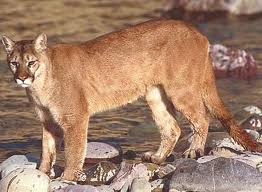 or dawn or duskÑthe primary reason that most, like me, have never seen one in the wild. They are the largest wildcats in North America, and mature males weigh up to 165 pounds and grow to more than eight feet in length--females weigh about 100 pounds (note: bobcats average about _ of this size). These powerful cats can leap as high as 15 feet and as far as 40 feet.
or dawn or duskÑthe primary reason that most, like me, have never seen one in the wild. They are the largest wildcats in North America, and mature males weigh up to 165 pounds and grow to more than eight feet in length--females weigh about 100 pounds (note: bobcats average about _ of this size). These powerful cats can leap as high as 15 feet and as far as 40 feet.
A mountain lion's life span is estimated at 12 years in the wild, although captive animals have lived up to 25 years. Female lions generally first reproduce at about two and one half years of age and usually produce two or three young (kittens) which they raise alone. Young mountain lions have spots, but adults do not. The kittens nurse for two months, and then start to travel with their mother at which time she teaches them to hunt. They will remain with their mother from 1.5 to 2 years. Males that enter another male's territory have been known to kill the kittens so that females will be more willing to mate.
There are an estimated 30,000 mountain lions in the western United States including about 5,000 in California. They are highly territorial, solitary animals that actively avoid other cats except during courtship. Their home ranges can vary in size from 10 square miles to around 370 square miles; females tend to have smaller ranges than males. Mountain lions are active hunters and may travel long distances in search of food. These cats employ a blend of stealth and power, stalking their prey until an opportunity arrives to pounce, then going fo![]() r the back of the neck with a fatal bite. They will hide large carcasses and feed on them for several days. After killing their prey, they will bury it and leave it, coming back to feed on it for several daysÑhalf-buried deer carcasses with the entrails remov
r the back of the neck with a fatal bite. They will hide large carcasses and feed on them for several days. After killing their prey, they will bury it and leave it, coming back to feed on it for several daysÑhalf-buried deer carcasses with the entrails remov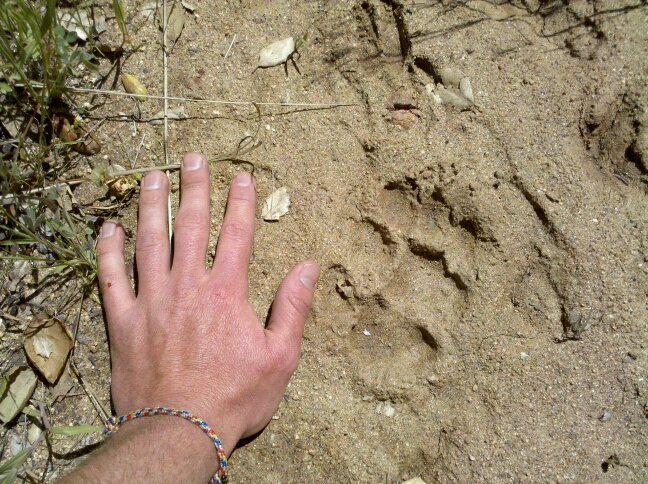 ed are a sure sign a mountain lion is nearby. In addition to deer, their preferred prey, lions also hunt for smaller mammals such as mice, squirrels,porcupines, raccoons, rabbits, beavers,and coyotes.
ed are a sure sign a mountain lion is nearby. In addition to deer, their preferred prey, lions also hunt for smaller mammals such as mice, squirrels,porcupines, raccoons, rabbits, beavers,and coyotes.
While they are dangerous and successful predators of large mammals, attacks on humans are rare. According to the California Department of Fish and GameÕs website, there have only been 16 documented human attacks in the state since 1890, and only four were fatal. Should you encounter a mountain lion on the canal, or anywhere else, this website recommends:
1. Do not run;
2. Instead, face the animal, make noise and try to look bigger by waving your arms;
3. Throw rocks or other objects;
4. Pick-up small children;
5. If attacked, fight back.
by Alicia Funk
This is the last chance to protect our neighborhood from this invasive fire hazard. Please remove the entire root and plant before the flowers on your property go to seed!
Every spring, the yellow flowers of invasive Scotch Broom (Cytisus scoparius, pea family) line local roadways.
Although pretty when in bloom, each plant can produce up to 40,000 seeds that can survive in the ground through drought and fire. Stands of Scotch Broom disrupt local streams and overtake native plants and wildflowers that local wildlife rely upon for survival. The highly flammable brush produces a fire hazard in Nevada Cou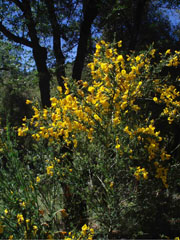 nty, an area especially vulnerable to fire.
nty, an area especially vulnerable to fire.
In California, it is a Class C noxious weed, which means the state attempts to control it, but it is up to volunteers to keep the plant from spreading. The only way to get rid of Scotch Broom is to remove the entire root system and plant. Look for annual broom removal workdays this spring, remove Scotch Broom before it goes to seed and grow native plants in your backyard for beauty, food and health for humans and our local habitat.
Pull small to medium plants by hand, easier after the rain, but large ones need to be removed with a special tool. Contact Jim
lvrmna@gmail.com to borrow the LVRMNA neighborhood root jack. The Firesafe Council also has an application to borrow scotch broom removal tools:http://www.areyoufiresafe.com/get-fire-help/scotch-broom-challenge/ or you can purchase your own: http://www.weedwrench.com. For more information on easy-to-grow native plants and their uses, visit www.livingwild.org.
[Editor's note: Some year ago the neighborhood association purchased a Root Jack for the purpose of uprooting the Scotch Broom plant. If you would like to borrow it for a time, just send a message to lvrmna@gmail.com]
In 1997 Frances Burton donated her 38 acre parcel to Bear Yuba Land Trust with intentions of keeping the land out of the hands of developers and for it to become a park for the enjoyment of Nevada County residents and a place for learning about nature. Today, we are confident that Ms. Burton would be proud of the progress we've made to turn her dreams into reality.
The collaboration of multiple groups who are dedicated to environmental education in a variety of aspects has created a place for any and all members of the community to enjoy and learn.
* The Food Love Project is a 1/3 acre educational farm site where Farmer Amanda, for her second year, creates a beautiful garden where children and adults come to learn about nutrition, food security and community involvement in growing, harvesting, eating and celebrating fresh food. This is a project under Living Lands Agrarian Network.
* Rick Berry leads his Fox Walkers Program. This program teaches the art and science of Wilderness Survival to children and adults. Three days a week you can find children in the forest building simple huts, making bows and arrows, and learning to track animals. All of these aspects create a deeper appreciation of nature.
 * The Tsi-Akim Maidu Tribe has an agreement for an active cultural center for tribal activities on a three-acre section of the property called Pata Panaka. This land is sacred to the tribe and the utmost respect is shown by all visitors to the property. Permission to enter this site can only be granted by the tribe.
* The Tsi-Akim Maidu Tribe has an agreement for an active cultural center for tribal activities on a three-acre section of the property called Pata Panaka. This land is sacred to the tribe and the utmost respect is shown by all visitors to the property. Permission to enter this site can only be granted by the tribe.
* Movimiento is a rural-urban youth environmental leadership program that works to nourish young people in being whole, healthy, and hopeful human beings who love and care for their communities and planet. Daniela Di Piero and her husband Robert Steffke lead this program that immerses youth in outdoor experiences which many would never get otherwise.
* The Bear Yuba Land Trust summer camp program has been operating for 3 weeks in June for the past dozen years. It's a multi-generational program for kids from ages 4 to 13, with a Junior Stewards counselor programs for teens through 18 years old, and for grandparents who help in all aspects of camp. About one-third of the kids attend on scholarships provided by donors in our community.
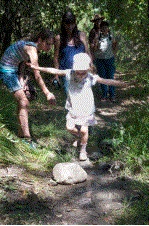
* Sierra Streams Institute has begun doing pond ecology classes for elementary field science programs.
* Trails throughout Burton Homestead are open to our neighbors for hiking.
Together with our partners, friends and neighbors we have created a truly unique site. And it continues to grow and change every day. There is ongoing riparian restoration on the streams as well as pond restoration. A yurt is being installed to accommodate small group activities during harsh weather conditions. The meadow area is being carefully monitored and preserved with the help of the Redbud Chapter of the California Native Plant Society, as a restoration site where groups can come to learn about the native wildflowers that grow in this unique ecological niche.
Our neighbors Rebecca Coffman and Jim Hurley are planning a new informational kiosk that will provide regular updates to everyone on activities at Burton. After it is installed just inside the parking lot you will be able to stop by and get updates. In the meantime, you can visit www.BearYubaLandTrust.org and click on the Burton Calendar of Events button to find out more.
It's a wonderful feeling to know that Frances Burton's final wishes are being upheld through our constant effort to improve this land and bring more people here to be immersed in environmental education. If you'd like to help, we are soliciting donations for the kiosk project - both in cash and in-kind. We are planning a community pot-luck so stay tuned. If you'd like to find out more, give us a call at 530-272-5994.
Hello Neighborhood!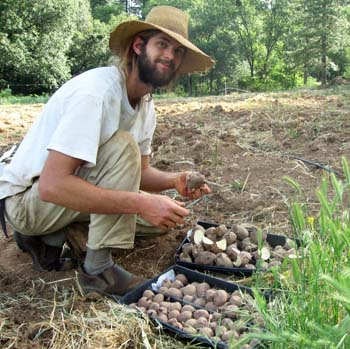
Happy Spring! My name is Tim Van Wagner and I have recently found myself beautifully situated with a piece of property on Rector Rd. Many of you may know the place, as I've seen many different folks walking their dogs or riding their bikes past the property. It's impossible to miss the historic, and quite large, wood-sided barn as you drive down the road. Brush Creek flows through the property and it's 37 acres reach far back towards Lake Vera/Purdon Rd, adjoining several houses at the end of Selby Lane.
If my name rings a bell with you it might be from my recent involvement with a local farming ground, the Living Lands Agrarian Network, or perhaps it goes back further to my days of public school at Deer Creek, Seven Hills or Nevada Union High School. I know at least two of my teachers from "back in the day" live in the neighborhood!
I would like to say hello to you all and say thank you for the many warm welcomes I have received so far. After having recently become acquainted with Jim Hurley, our extremely welcoming and enthusiastic neighborhood association chair?, I was asked to write a brief article about what my plans are for this amazing piece of land, the Steber Ranch.
As I briefly mentioned above, I have been active during the past five years in co-founding and running a non-profit organization, Living Lands (www.livinglandsagrariannetwork.org). The primary work of the organization has been to provide in-depth, hands-on agricultural training to "beginning farmers" and "interns", facilitate the creation of a network of small-scale local farms, and more recently, to extend our educational efforts to the youth populations in our community. Already, two of our farms are located within our neighborhood association. The first was established in 2008 on Misty Meadows Lane. Many of you know about it, I'm sure. Now in its 5th year of production, the site is completely equipped with the necessary infrastructure to grow lots of vegetables and flowers for our farmers markets and a local CSA (community supported agriculture) program. The other site, a project we call the "Food Love Project" is located on the Burton Homestead and is the main site for our school groups and summer kids camps. It's hard to miss as you drive around the bend.
My plans for the old "Steber Ranch" are to create a vibrant, diverse, and productive farm. I look to build on the rich history that has existed on the property and neighboring lands by creating and maintaining a farm that produces nourishing, wholesome food for the local community. Hand in hand with this intention is a land-stewardship ethic that focuses on long-term soil fertility, water quality, forest health, and coexistence with the native flora and fauna.
Since January 1st of this year I have begun laying the infrastructural foundation for First Rain Farm. This work will support a number of enterprises on the land. Beginning this year I will be cultivating roughly two acres of mixed vegetables. Some of the vegetables I grow are kale, chard, collards, parsley, green onions, potato onions, squash, tomatoes, beets, carrots, and more! Many of these crops I sell to the Briarpatch Community Market as well as the Nevada City Farmers Market. I have already received numerous requests for a neighborhood farm stand! Something to consider.... As part of the acreage in vegetables, I also grow vegetable SEED. Many of the crops I grow for market as fresh vegetables, I also grow for seed, which I then sell to a local company, Sierra Seeds. Sierra Seeds then packages and distributes the seeds at various retail outlets, including Briarpatch. Growing pure seed requires in-depth knowledge of the different plant families and species, as well as multiple fields in which to grow crops in isolation of one another. I am fortunate to have both of these things at my disposal!
With a large portion of the remaining acreage the plan is to plant an orchard (next winter), raise dairy goats (currently and into the future), and lightly run pigs through some of the forested areas and the pasture (currently in the works). Precise animal management is achieved on my farm thanks to the help of cutting -edge electric fence systems which allow for controlled grazing and frequent movement of the animals, thus resulting in more productive pasture and brush-land, while avoiding the problems associated with over-grazing.
This land feels like a hidden treasure. The berries have had years to grow neck high around the creek, the pine and cedar trees have grown well above the alders, willows, oaks, and madrone; blocking the sunlight and causing dieback. The pastures are matted with years of un-grazed grass, now smothering the plants and creating sparse fields in comparison to what they could be. The barns need some tender loving care that only the daily routine of keeping animals, well, can do. The land calls for new memories to be created, for laughter to cascade down the hills, under the shade of the trees, and through the sound of pond water splashing. For homegrown meals with friends gathered 'round and music and dancing under the yellow harvest moon. This land is coming back to life in the years to come...
Thank you again for your open arms. I look forward to getting to know you all in the ways that neighbors do!
Sincerely,
Tim Van Wagner First Rain Farm
Editor's note: If you would like to locate First Rain Farm on the map, click here.
As spring continues to unfold, we farmers of the Food Love Project at Burton Homestead are tilling in our cover crop, preparing planting beds, and getting ready for the many groups of school children that will begin passing through our gates next week. We’re looking forward to planting, learning, and playing with the many kids that the farm will serve this May! You may have also noticed our most recent visitor, Stella, a beautiful cow who’s been loaned to us in order to help us with our booming cover crop. We’re feeding her delicious greenery in exchange for fertility!
If you aren’t already familiar with the Food Love Project, here’s some background information to help you understand what’s going on at that sunny piece of land behind the deer fence at the homestead that you drive by each day. Food Love was established in conjunction with the Living Lands Agrarian Network in 2010, and serves as an educational garden for local schoolchildren and community volunteers. The farm is devoted to promoting nutrition education, food security, and community involvement in growing, harvesting, eating, and celebrating fresh food! We provide experiential field trips, service projects, and classroom visits to local schools throughout the year.
Farmer Amanda Thibodeau is continuing her hard work this year and has been joined by a new team member, intern Katie Turner; we would both love for any and all of you to stop by the farm this season! One Wednesday each month, Food Love will host a volunteer work/education day through the Living Lands Agrarian  Network. Please visit livinglandsagrariannetwork.org for more details on how to get involved. Food Love will also be hosting regular volunteer days for community members every Friday from 9 am to 1 pm this season. Please email us at foodloveproject@gmail.com if you have any questions, and see our wish list on the Living Lands website for other ways to contribute.
Network. Please visit livinglandsagrariannetwork.org for more details on how to get involved. Food Love will also be hosting regular volunteer days for community members every Friday from 9 am to 1 pm this season. Please email us at foodloveproject@gmail.com if you have any questions, and see our wish list on the Living Lands website for other ways to contribute.
For the next seven months, Food Love will be growing, harvesting, and teaching; and, although the school year ends in June, we plan to continue the fun with three sessions of Food Love Day Camp on July 12, 19, and 26! Each day the camp will run from 9 am to 1 pm, and cost $30 per child. Session 1 will be devoted to ages five through seven, Session 2 will host ages eight through ten, and Session 3 will be for those aged eleven and up. Each camp will include harvesting, planting, and a special farm art project! Please email us for more information and to register. Food Love will also be involved with the Bear Yuba Land Trust Summer Camp in June; for more information see bylt.org.
Some of you may also remember the Food Love farm stand on Lake Vera Road that was set up every Wednesday last summer. We’re planning to continue the farm stand tradition this summer, but we’ll be moving it to Tuesdays, and starting in late June. The produce will be available from 9 am to 6 pm each Tuesday, and there will be a donation box on the stand where you can pay for your food. We’ll be selling bouquets of flowers and a variety of veggies from our farm, and proceeds will support the Food Love Project!
Our farm network, Living Lands, also has some exciting events coming up this summer. On July 15th, Living Lands will host a farm tour and festival where you can come out to visit the many farm sites and take part in a fun community gathering. On August 25th, Living Lands will host a Farm to Table dinner, featuring fresh local produce and a beautiful outdoor setting. Please see our web site for more details on both events.
To close out the season on October 6, Food Love is planning a Harvest Festival that will feature a pumpkin patch, face painting, veggie tasting, and more. We would love to see you there!
Stella, the cow, still hard at work.
Editor's note: If you would like to locate Amanda'a farm on the map, click here.
Soil Sister’s Farm is a rich acre of land tucked up in the Selby Flat area in between Misty Meadows Lane and Mandolin Rd. It began as a farm site five years ago when Leo Chapman and Tim Van Wagner approached Wendy and Corbett Riley and asked them if they would be interested in allowing their back field to be farmed. It became a Living Lands site at that point, and for the last five years has been producing a copious amount of vegetables and flowers. This site has the wonderful distinction of being a flat bottomland area amidst plenty of steep hills, and thus has accumulated a generous few feet of topsoil. It lies in a hollow, so remains cooler during the summer months and has a swamp-like suck on your feet all spring. Every season we listen to red-winged blackbirds in the pond next-door, watch the barn swallows build their nests and fledge, and lead into the winter with the warbles of the migrating sandhill cranes. It is truly a piece of land graced by the presence of wildlife and laughing farmers.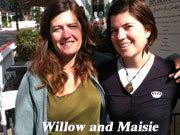
For the last three years this site has been farmed by Maisie Ganz and myself under the name of Soil Sister’s farm. We began this project as new farmers, just starting to develop the well-worn calluses of our own farm. We had very clear intentions to make this project about empowering each other as women farmers and creating a sustainable farm business that valued balanced lives as well as ecological agriculture. A tall order to fill, and yet this third season has brought an ease with the work that can only come with experience and a modicum of success.
On this acre of land we grow a large variety of vegetables, which supply our 30 family CSA project, as well as the hungry campers at Camp Augusta. We also sell at the Saturday morning farmer’s market in Nevada City with other Living Lands farmers and to several restaurants. Because our site is cooler in the summer, we can specialize in lettuce, salad mix, kale, and other crops that don’t tolerate the heat. I have a special place in my heart for growing flowers, and every year we try to grow more of them. We have a flower share add-on to our CSA and sell bouquets at the farmer’s market. We also grow and arrange flowers for weddings and events. Come walk down Misty Meadow’s Lane some late August evening and you will see the sunflowers nodding to you over the fence while the zinnias shine in the dusky light.
As of now we still have CSA shares available, and would love to feed the neighborhood right around us. Please visit http://livinglandsagrariannetwork.org/?page_id=2254 for more information or e-mail us at soilsistersfarm@gmail.com. Feel free to say hello if we are out working and you are walking by; it’s great to meet the neighbors!
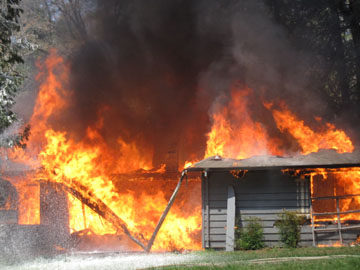
This home on Rector Road suffered irreparable water damage some years back and finally, after some skirmishes with the insurance company, it had to come down. The Fire District took the opportunity on Friday, April 27, 2012 to burn it down in order to hone their fire fighting skills.
This is the last such demolition by fire that will be allowed. Some of the reasons are potential for toxics getting into the air (lead paint, for example) and air pollution of course.
The site will be cleaned up after the burn and, eventually, the home will be rebuilt.
We shot a film (not something we are good at) and have posted the movie on YouTube.
 We are losing three of the most faithful members of our steering committee, Paul, Linda, and June. They are moving away from the neighborhood.
We are losing three of the most faithful members of our steering committee, Paul, Linda, and June. They are moving away from the neighborhood.
For a number of year, the Carlson's allowed us to use their front yard fronting Lake Vera Road as the site of our annual yard sale. It was a perfict spot.
Paul is moving off with his wife Linda to enjoy the high seas in their sail boat. Paul was our steady, always composed chair for many years, doubling as chief chef and bottle washer at our neighborhood picnics. Linda was our unofficial gardner, providing timely tips in our newsletter, and providing the backbone of our roadside daffodil program. Bon Voyage.
 June is leaving to be closer to her family in Sacramento. June has been our most faithful, hard-working treasurer and worked on every behind-the-scenes chore that has come along, including yard sales, picnics, getting out the newsletter and you name it. I don't know what we will do without her relentlessly upbeat personality. We will miss you June.
June is leaving to be closer to her family in Sacramento. June has been our most faithful, hard-working treasurer and worked on every behind-the-scenes chore that has come along, including yard sales, picnics, getting out the newsletter and you name it. I don't know what we will do without her relentlessly upbeat personality. We will miss you June.
Want Ads
Massage and Ayurvedic Panchakarma for Pain Relief and Deep Relaxation. 265-8811
(www.lotushealingsanctuary.com). Sliding Scale available for members of LVRMNA.
Ty Smith: Drum, General Music Lessons (Guitar)
Drum Set/ Percussion- All styles. Jazz, Rock, Fusion, Rudimental,World, (African, Cubano, Brazilia, Mexico, Euro. etc.). Grooves and Fills.
Time! - Listening - Reading
Guitar: Electric, Acoustic, Fingerpicking, Hybrid picking.
· Folk, Blues, Rock, Etc. Beginning Jazz.
· Slide guitar- Dropped and open tunings.
· Theory: Notes and Chords-
· Intervalic relationships. Reading and Hearing!
· Jobbing Professional: Educator/Player
· Convenient Rector Rd. Studio
Call 265-4232
Robert Grotke
Man-around-the-houseI am available for yard work, clean-up and hauling, and those odd
jobs. Sorry, but plumbing and electrical I leave for those other guys.
I will mow, rake, and weed whack, also some light chainsaw work. If you
need some help, please give me a call to see if my services will
benefit you. 265-5968. Ask for Rob. My usual rate is $20/hr. Local
references available. Thanks.
Full service sharpening:
Sharpening service in your neighborhood--saws, chippers, knives, scissors by professional.
Call for drop off or pick up Russ Pingree 265-4149.
Work wanted:
Julian Eisen: Pet sitting, house sitting, yard work.
Graduating Senior NUHS, raising funds toward college tuition.
Affordable, experienced, and responsible.
References available upon request.
Call: 265-3809
We offer Bobcat tractor service, and construction from frame to finish work. Labor services such as brush and timber clean-up, painting and roof repairs. General Building Contractor and Landscape Contractor Lic. No. 685711
Call: 587-2895 or 362-1202
Barbara DesChamps
helps you find a flattering wardrobe
and travel in style and comfort with
less luggage. For services and books,
visit chateaupublishing.com
or call 265-5851 after 10 a.m.
Handyman/Yard/Maintenance Worker Wanted
$13/Hr, must be able to lift 75 pounds, variable hours.
Contact Pam at (530) 265-0858.


Katherine Porebski
Are you thinking of Buying or Selling Real Estate Property?
I'm your Neighborhood Expert, with 12 successful years of
Local Real Estate Experience.
Please call or email Katherine Porebski, Realtor,
for more information and you can start packing today!
530-265-8299 or KPorebski@sbcglobal.net
We are Neighbors helping Neighbors
The purpose of the Lake Vera/Round Mountain Neighborhood Association is to sustain the quality of our rural environment and foster a sense of community for present and future residents. Some of the current activities designed to implement these goals are: Annual picnic, yard sale, newsletter, outside speakers , fire prevention, working with children's camps, initiating neighborhood cooperatives such as the Propane and Septic Coops, and generally sustaining the quality of our environment.
We ask you to join the Association. Benefits include functioning as a community, a quarterly (more or less) newsletter, implementation of neighborhood projects, and, we can provide a united force to address neighborhood issues before governing bodies. To become a member send your name, address, phone number, (since we now have an all-electronic presence, our expenses are greatly reduced and so all dues are temporarily suspended) to Lake Vera/Round Mountain Neighborhood Association, P.O. Box 2291, Nevada City, CA 95959. For information, call 265-9334.
Name:______________________________________________
Address:_____________________________________________
Phone:_________________ E-mail: _________________________Amount enclosed:____________
LAKE VERA/ROUND MOUNTAIN
NEIGHBORHOOD ASSOCIATION
P.O. BOX 2291
NEVADA CITY, CA. 95959
Chair: Jim Hurley
Secretary: Open
Newsletter Editor: Jim Hurley
Camp Liaison: Open
Fire Prevention Coordinator: Bill Wilson
Arrangement/Hospitality: Sandra Rockman
The LVRMNA newsletter is published by the
Lake Vera/ Round Mountain Neighborhood
Association as a community and educational service.Email: LVRMNA@gmail.com
Web site: http://lvrmna.on-rev.com